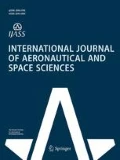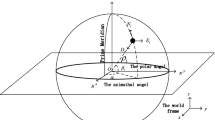Abstract
This paper discusses the circumnavigation of multiple drones around a moving target in an urban area and proposes an integrated solution accounting for estimation, guidance and control. For performing this circumnavigation task, three objectives must be achieved at a steady state: (1) The target and the drones must be on the same plane; (2) The drones must rotate around the target while maintaining a constant distance to the target; and (3) Each drone must be able to avoid collisions with the other drones. To achieve these three objectives, a vector-field-based guidance law can be designed to generate the velocity command which is then integrated to be the position command for each drone. However, in the course of implementing this guidance law, the target’s position and velocity information is continuously required, which is unlikely to be the case in an urban environment. To address this issue, a probability function modeling the intermittent or discontinuous observation can be added to the typical Kalman filter, so that the target position is continuously estimated. In addition, when there is a bias in the observation of drone, the bias has to be eliminated by adding a consensus logic (information exchange between neighboring drones) to the correction step of the Kalman filter, resulting in so-called Kalman Consensus Filter (KCF). However, KCF only guarantees the asymptotic convergence to an estimate of the target state which adversely affects the control performance, and so a novel consensus logic, so-called Kalman Finite-time Consensus Filter (KFCF), is proposed for the finite-time convergence and the control performance improvement. The guidance law combined with the estimation scheme (KFCF) is then tracked by each drone being equipped with the Integral Sliding Mode Control (I-SMC) law yielding the finite-time convergence to a prescribed sliding surface in the presence of bounded disturbances. Integrated numerical simulations show the merit of the proposed method.















Similar content being viewed by others
Notes
Note that although ε is optimized for a particular simulation scenario, the same value of ε results in good performance even for 100 different scenarios as shown in Fig. 10.
The tracking error for each simulation scenario is the difference between the position guidance command in the case of perfect observation (λ = 1) and the drone’s actual position in the case of intermittent observation (λ = 0.9).
References
Zhong H et al (2019) Circumnavigation of a moving target in 3D by multi-agent systems with collision avoidance: an orthogonal vector fields-based approach. Int J Control Autom Syst 17.1:212–224
Li D et al (2019) Cooperative circumnavigation control of networked microsatellites. IEEE Trans Cybern 50.10:4550–4555
Li R, Shi Y, Song Y (2018) Localization and circumnavigation of multiple agents along an unknown target based on bearing-only measurement: a three-dimensional solution. Automatica 94:18–25
Seyboth GS et al (2014) Collective circular motion of unicycle type vehicles with nonidentical constant velocities. IEEE Trans Control Netw Syst 1.2:167–176
Hernandez S, Paley DA (2010) Three-dimensional motion coordination in a spatiotemporal flow-field. IEEE Trans Autom Control 55(12):2805–2810
Scardovi L, Leonard N, Sepulchre R (2008) Stabilization of three-dimensional collective motion. Commun Inf Syst 8.4:473–500
Ramirez-Riberos JL et al (2010) Distributed control of spacecraft formations via cyclic pursuit: Theory and experiments. J Guid Control Dyn 33.5:1655–1669
Franchi A, Stegagno P, Oriolo G (2016) Decentralized multi-robot encirclement of a 3D target with guaranteed collision avoidance. Auton Robot 40.2:245–265
Lawrence DA, Frew EW, Pisano WJ (2008) Lyapunov vector fields for autonomous unmanned air-craft flight control. J Guid Control Dyn 31.5:1220–1229
Frew EW, Lawrence DA, Morris S (2008) Coordinated standoff tracking of moving targets using Lyapunov guidance vector fields. J Guid Control Dyn 31.2:290–306
Yoon S, Park S, Kim Y (2013) Circular motion guidance law for coordinated standoff tracking of a moving target. IEEE Trans Aerosp Electron Syst 49.4:2440–2462
Goncalves VM et al (2010) Vector fields for robot navigation along time-varying curves in n-dimensions. IEEE Trans Robot 26.4:647–659
Milutinovic D, Casbeer D, Cao Y, Kingston D (2014) Coordinate frame free Dubins vehicle circumnavigation. In: American Control Conference, pp. 891–896
Milutinovi D, Casbeer D, Cao Y, Kingston D (2017) Coordinate frame free Dubins vehicle circumnavigation using only range-based measurements. Int J Robust Nonlinear Control 27(16):2937–2960
Matveev AS, Teimoori H, Savkin AV (2011) Range only measurements-based target following for wheeled mobile robots. Automatica 47(1):177–184
Yang X, Hanlin D (2019) Non-singular terminal sliding mode control for fast circumnavigate mission centered on non-cooperative spacecraft. In: 2019 Chinese Automation Congress (CAC). IEEE
Shtessel Y et al (2014) Sliding mode control and observation, vol 10. Springer, New York
Fax JA, Richard MM (2004) Information flow and cooperative control of vehicle formations. IEEE Trans Autom Control 49.9:1465–1476
Olfati-Saber RJ, Alex F, Richard MM (2007) Consensus and cooperation in networked multi-agent systems. Proc IEEE 95.1:215–233
Oh K-K, Ahn H-S (2012) Formation control of mobile agents based on distributed position estimation. IEEE Trans Autom Control 58(3):737–742
Peng Z et al (2016) Distributed consensus-based formation control for nonholonomic wheeled mobile robots using adaptive neural network. Nonlinear Dyn 86.1:605–622
Oh K-K, Ahn H-S (2011) Formation control of mobile agents based on inter-agent distance dynamics. Automatica 47.10:2306–2312
Zelazo D et al (2015) Decentralized rigidity maintenance control with range measurements for multi-robot systems. Int J Robot Res 34.1:105–128
Oh K-K, Ahn H-S (2017) Leader-follower type distance-based formation control of a group of autonomous agents. Int J Control Autom Syst 15(4):1738–1745
Franchi A et al (2012) Modeling and control of UAV bearing formations with bilateral high-level steering. Int J Robot Res 31.12:1504–1525
Zhao S et al (2014) Distributed control of angle-constrained cyclic formations using bearing-only measure-ments. Syst Control Lett 63:12–24
Zhao S, Zelazo D (2015) Bearing rigidity and almost global bearing-only formation stabilization. IEEE Trans Autom Control 61.5:1255–1268
Li W, Jia Y, Junping Du (2015) Distributed Kalman consensus filter with intermittent observations. J Franklin Inst 352.9:3764–3781
Liu P, Tian Y-P, Zhang Ya (2018) Distributed kalman filtering with finite-time max-consensus protocol. IEEE Access 6:10795–10802
Wang A, Nankun M, Xiaofeng L (2018) Min–Max consensus algorithm for multi-agent systems subject to privacy-preserving problem. In: International Conference on Neural Information Processing. Springer, Cham
Khan UA, Ali J (2011) On the stability and optimality of distributed Kalman filters with finite-time data fusion. In: Proceedings of the 2011 American Control Conference. IEEE
Beard RW (2008) Quadrotor dynamics and control. Brigham Young Univ 19.3:46–56
Park Y, Woohyun J, Kim Y (2020) Multiple drone control for vector-field guided circumnavigation. Int Conf Control Autom Syst: 1245–1247
Zhao D, Li C, Zhu Q (2011) Low-pass-filter-based position synchronization sliding mode control for multiple robotic manipulator systems. Proc Inst Mech Eng Part I J Syst Control Eng 225(8):1136–1148
Wang L, Xiao F (2010) Finite-time consensus problems for networks of dynamic agents. IEEE Trans Autom Control 55(4):950–955
Tien R, Kim Y (2018) Decentralized formation flight via PID and integral sliding mode control. Aerop Sci Technol 81:322–332
Acknowledgements
This work was supported by the National Research Foundation of Korea (NRF) Grant funded by the Korea Government (MSIT) (No. 2021R1A2C1004547 and 2017R1A5A1015311).
Author information
Authors and Affiliations
Corresponding author
Ethics declarations
Conflict of Interest
On behalf of all authors, the corresponding author states that there is no conflict of interest.
Additional information
Publisher's Note
Springer Nature remains neutral with regard to jurisdictional claims in published maps and institutional affiliations.
Rights and permissions
About this article
Cite this article
Park, Y., Kim, Y. Circumnavigation of Multiple Drones Under Intermittent Observation: An Integration of Guidance, Control, and Estimation. Int. J. Aeronaut. Space Sci. 23, 423–433 (2022). https://doi.org/10.1007/s42405-022-00450-x
Received:
Revised:
Accepted:
Published:
Issue Date:
DOI: https://doi.org/10.1007/s42405-022-00450-x



